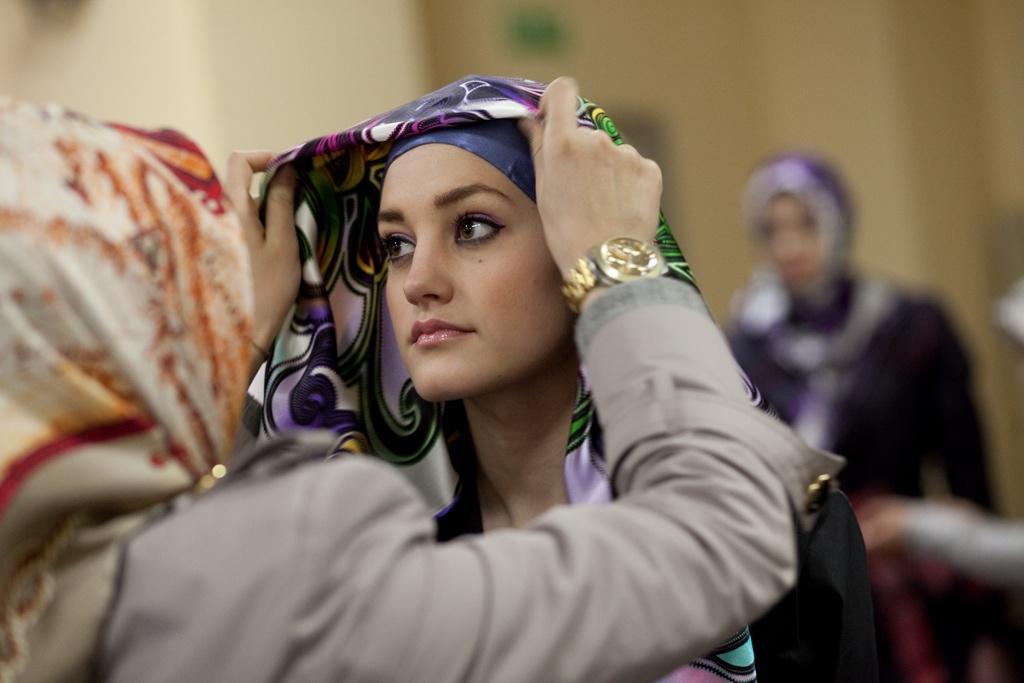Don’t be so modest: How Islam is upending the fashion world
Backstage, Eastern European models get outfitted for a fashion show at the Islamic Fashion Expo on March 3, 2011.
Here's an interesting twist: the most unlikely of industries — the fashion world — is getting a lesson in innovation from Islam.
There are two ways this is happening. One, Islamic fashion represents a $95 billion global industry, according to The Guardian, a figure likely to grow along with the expanding world Muslim population.
With those kinds of profits to be made, designers hit by the global economic downturn appear to be following the money (cough, Vivienne Westwood's Barjis Chohan).
Then there's style. This is Fashion Week, after all. Long have we been complaining about a lack of, well, newness in the industry. What did the 1990s have to say for themselves? Jean jackets? Tie-dye? As for the 2000s … the lesser of various evils appears to be a return to the fifties (à la Michelle Obama).
The point is, the constraints presented by Muslim values — e.g., the idea that a woman's body is respected when most of it is decidedly not on display — have proven a creative challenge for an industry long accustomed to unfettered freedom of expression, not to mention Western sensibilities increasingly hard to shock.
What are designers coming up with? Honestly, some pretty badass outfits. Check out the sumptuous dresses created by US designer Nzinga Knight, herself a Muslim. Clean lines and ebullient colors combine in forms that nod to a woman's natural sensuality — Knight's dresses may not be made for super-conservative Wahabbi-style Muslims, but for the moderate majority, they're likely to hold great appeal.
Meanwhile, a new modeling agency for Muslim models, called Underwraps, launched in New York City and had its first runway show in September, with founder Nailah Lymus telling Fashionista the agency is trying to bridge the gap felt between Muslim models and their Western counterparts.
“We take things seriously and are professional just like other models," Lymus said. "During Fashion Week I’ll be sending them out to castings just like anyone else."
Also closing the gap are a growing cohort of fashion-forward Muslim bloggers with their own take on matters. In "Balancing Fashion & Faith: A Look at Muslim Style Bloggers," Taylor Davies of Independent Fashion Bloggers offers a run-down of how major players in the online Muslim community feel about this issue.
"I find that almost every trend can be worked into a more modest look," blogger Asma of Haute Muslimah told Davies. "I mean, except if the trend is mini[skirt]s — well, even then I suppose you could rock them with pants."
Which a lot of ladies do. The Guardian's Sara Ilyas says it's "easier to be a fashionable Muslim in Britain these days — walk down Oxford street and stereotypes of the hijab as bland and restrictive are laughable," she wrote, describing "gaggles of friends wearing bright leopard print H&M shawls as a hijab, girls with a mountain of fabric piled up to create a beehive style hijab — hell, I even saw a lady wearing a glittery blue cardigan as a headscarf once (I saw the sleeve hanging out)."
All that mixing and matching is where Barjis Chohan's new line of clothing comes in. Chohan, who worked under designer Vivienne Westwood, told The Guardian that "fashionable Muslims are struggling to buy clothes" due to "unsuitable hemlines and necklines, and they resort to wearing layers, which are very hot and uncomfortable in the summer." Her new line is intended "to fill this gap," by providing "practical, high-quality, modest and fashionable day and evening wear for the busy, modern woman."
Knight, the US designer, seized a similar opportunity. "My aesthetic was something really missing in the market,” the designer told AFP. “It’s very distinct and can give me an edge." When she first started working in fashion back in 2008, she decided modesty was getting a bum rap in the industry.
“It seemed each designer had the same point of view" in terms of style, she said, referring to the high demand for open-back, cleavage-showing dresses. “I felt a lot of women were wearing things because that’s what the magazines told them."
Indeed, resistance to catwalk eye candy is moving beyond traditionally religious circles. Women (and girls!) are rejecting the Barbie Doll-style Western female image not only on practical grounds but as a form of outright discrimination. The fashion industry is seen as an accomplice. So an increasing number of women, many of them feminists, are allying with the Muslim designers on this one. What's next, modest clothing becoming a legit fashion trend? Who knows, but if so, this is the week to reveal it.
We want to hear your feedback so we can keep improving our website, theworld.org. Please fill out this quick survey and let us know your thoughts (your answers will be anonymous). Thanks for your time!
